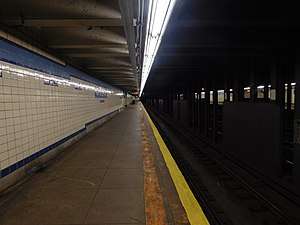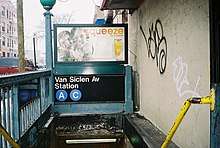Van Siclen Avenue station (IND Fulton Street Line)
Van Siclen Avenue is a local station on the IND Fulton Street Line of the New York City Subway. Located at the intersection of Van Siclen and Pitkin avenues in the East New York neighborhood of Brooklyn, it is served by the C train at all times except nights, when the A train takes over service.
Van Siclen Avenue | |||||||||
|---|---|---|---|---|---|---|---|---|---|
 Van Siclen Avenue station inbound platform in October 2019 | |||||||||
| Station statistics | |||||||||
| Address | Van Siclen Avenue & Pitkin Avenue Brooklyn, NY 11207 | ||||||||
| Borough | Brooklyn | ||||||||
| Locale | East New York | ||||||||
| Coordinates | 40.672697°N 73.890266°W | ||||||||
| Division | B (IND) | ||||||||
| Line | IND Fulton Street Line | ||||||||
| Services | A C | ||||||||
| Structure | Underground | ||||||||
| Platforms | 2 side platforms | ||||||||
| Tracks | 4 | ||||||||
| Other information | |||||||||
| Opened | November 28, 1948 | ||||||||
| Station code | 186[1] | ||||||||
| Wireless service | |||||||||
| Opposite-direction transfer available | Yes | ||||||||
| Traffic | |||||||||
| Passengers (2019) | 918,811[3] | ||||||||
| Rank | 371 out of 424[3] | ||||||||
| Station succession | |||||||||
| Next west | Liberty Avenue: A | ||||||||
| Next east | Shepherd Avenue: A | ||||||||
| |||||||||
| |||||||||
| |||||||||
Construction on the Van Siclen Avenue station started in 1938 as part of a four-station extension of the Fulton Street subway eastward under Pitkin Avenue toward Queens. Work was delayed by funding problems due to World War II, even though the stations were mostly complete. Construction resumed on the extension of the Fulton Street Line in November 1946, and this part of the Fulton Street Line opened in 1948. The extension of the Fulton Street subway replaced the Fulton Street elevated line, which closed afterward.
History

Van Siclen Avenue was part of a four-station extension of the Fulton Street subway along Pitkin Avenue, past its original planned terminus at Broadway Junction.[4][5][6] The Fulton Street subway was the city-owned Independent System (IND)'s main line from Downtown Brooklyn to southern Queens.[4]
Further construction past the line's initial terminal at Rockaway Avenue was delayed by funding problems due to the Great Depression in the 1930s.[7] This was temporarily solved by federal Works Progress Administration funding starting in 1936. The portion continuing from east of Rockaway Avenue along Pennsylvania and Pitkin Avenues to Crystal Street, including the Van Siclen Avenue station, began construction in 1938.[6][8] The progress lasted only a few years, as all work on the last portions in Brooklyn was stopped by December 1942 shortly after the United States entered World War II due to material sortages, with Broadway−East New York complete but not in operation due to lack of signal equipment, and the remaining stations to Euclid Avenue as unfinished shells.[7][9][10] At the time, work on the section that included the Van Siclen Avenue station was more than 99% complete, but vital equipment had yet to be installed, precluding its opening.[8]
Construction resumed on the extension of the Fulton Street Line in November 1946,[11][12] following the conclusion of the war and the allocation of funds obtained by Mayor William O'Dwyer.[13][7] After several test runs, the station opened to the public in the early morning of November 28, 1948, along with the rest of the line to Euclid Avenue.[6][14] The cost of the extension was about $46.5 million.[7][15] Because Van Siclen Avenue and three other stations were completed later than the rest of the line, they received different design features than other IND stations, including different wall tiles and fluorescent lighting.[7][6][16] It later became the replacement for the elevated BMT Fulton Street Line's Van Siclen Avenue station, which closed on April 26, 1956 when the connection to the eastern Fulton elevated was opened.[8][17]
Under the 2015–2019 Metropolitan Transportation Authority Capital Program, the station, along with thirty other New York City Subway stations, was slated to undergo a complete overhaul and would have been entirely closed for up to six months. Updates would have include cellular service, Wi-Fi, charging stations, and improved signage and station lighting.[18][19] However, most of these renovations were deferred until the 2020–2024 Capital Program due to a lack of funding.[20]
Station layout
| G | Street level | Exit/entrance |
| M | Mezzanine | Fare control, station agent, MetroCard machines |
| P Platform level |
Side platform | |
| Westbound local | ← ← | |
| Westbound express | ← | |
| Eastbound express | | |
| Eastbound local | | |
| Side platform | ||
This underground station has two side platforms and four tracks. The two express tracks are used by the A train during daytime hours.[21] There are no ads in the station.
Exits
There is a crossover and a single double wide stairway from each platform to the mezzanine. Outside of fare control, exits lead to all four corners of Pitkin Avenue and Van Siclen Avenue.[22]
References
- "Station Developers' Information". Metropolitan Transportation Authority. Retrieved June 13, 2017.
- "NYC Subway Wireless – Active Stations". Transit Wireless Wifi. Retrieved November 13, 2019.
- "Facts and Figures: Annual Subway Ridership 2014–2019". Metropolitan Transportation Authority. 2020. Retrieved May 26, 2020.
- Duffus, R.L. (September 22, 1929). "Our Great Subway Network Spreads Wider; New Plans of Board of Transportation Involve the Building of More Than One Hundred Miles of Additional Rapid Transit Routes for New York" (PDF). The New York Times. Archived (PDF) from the original on February 12, 2018. Retrieved August 19, 2015.
- Proposed Additional Rapid Transit Lines And Proposed Vehicular Tunnel. Board of Transportation of the City of New York Engineering Department. August 23, 1929. Archived from the original on January 22, 2018. Retrieved January 21, 2018.
- "Trains Roll on $47,000,000 Fulton St. Subway Extension". Brooklyn Daily Eagle. November 29, 1948. p. 2. Archived from the original on October 28, 2016. Retrieved October 9, 2015 – via Newspapers.com.
- Raskin, Joseph B. (2013). The Routes Not Taken: A Trip Through New York City's Unbuilt Subway System. New York, New York: Fordham University Press. doi:10.5422/fordham/9780823253692.001.0001. ISBN 978-0-82325-369-2.
- Linder, Bernard (February 2006). "Fulton Street Subway". New York Division Bulletin. Electric Railroader's Association. 49 (2): 2. Archived from the original on September 20, 2016. Retrieved August 27, 2016.
- Blauvelt, Paul (June 9, 1946). "Shortages Snarl $50,000,000 Tube Links". Brooklyn Daily Eagle. p. 21. Retrieved October 9, 2015 – via Newspapers.com.
- "Priorities May Halt Work on Fulton Tube: Vital Defense Materials Are Needed To Complete Spur to Queens County Line". Brooklyn Daily Eagle. November 18, 1941. p. 3. Archived from the original on January 27, 2017. Retrieved August 26, 2016 – via Newspapers.com.
- Jaffe, Alfred (December 6, 1946). "Borough Subway Relief Still 2 or 3 Years Off". Brooklyn Daily Eagle. pp. 1, 5. Archived from the original on October 28, 2016. Retrieved October 9, 2015 – via Newspapers.com.
- "Last Word in Subways and Cars for Boro". Brooklyn Daily Eagle. November 23, 1948. p. 8. Archived from the original on October 28, 2016. Retrieved October 9, 2015 – via Newspapers.com.
- Sparberg, Andrew J. (October 2014). From a Nickel to a Token: The Journey from Board of Transportation to MTA. Fordham University Press. ISBN 978-0-8232-6190-1.
- "Fulton Subway Stations Open After All-Night 'Dry Runs'". Brooklyn Daily Eagle. November 28, 1948. Archived from the original on October 28, 2016. Retrieved October 9, 2015 – via Newspapers.com.
- Report for the three and one-half years ending June 30, 1949. New York City Board of Transportation. 1949. hdl:2027/mdp.39015023094926.
- "Last Word in Subways and Cars for Boro". Brooklyn Daily Eagle. November 23, 1948. p. 8. Retrieved October 9, 2015 – via Newspapers.com.
- "First Leg of Rockaways Transit Opened at Cost of $10,154,702" (PDF). nytimes.com. The New York Times. April 30, 1956. Archived (PDF) from the original on February 12, 2018. Retrieved June 29, 2015.
- "MTA Will Completely Close 30 Subway Stations For Months-Long "Revamp"". Gothamist. Archived from the original on August 1, 2016. Retrieved July 18, 2016.
- "MTAStations" (PDF). governor.ny.gov. Government of the State of New York. Retrieved July 18, 2016.
- Berger, Paul (April 3, 2018). "New York Subway Cuts Back Plans to Renovate Stations". Wall Street Journal. ISSN 0099-9660. Retrieved April 3, 2018.
- Dougherty, Peter (2020). Tracks of the New York City Subway 2020 (16th ed.). Dougherty. OCLC 1056711733.
- "MTA Neighborhood Maps: Van Siclen Av (C)" (PDF). mta.info. Metropolitan Transportation Authority. September 2018. Retrieved March 29, 2019.
External links
| Wikimedia Commons has media related to Van Siclen Avenue (IND Fulton Street Line). |
- nycsubway.org – IND Fulton Street Line: Van Siclen Avenue
- Station Reporter — C Train
- The Subway Nut — Van Siclen Avenue Pictures
- Van Siclen Avenue entrance from Google Maps Street View
- Platforms from Google Maps Street View



%26groups%3D_22cd2984bea6a4329bed28ffb067b53df455542d.svg)